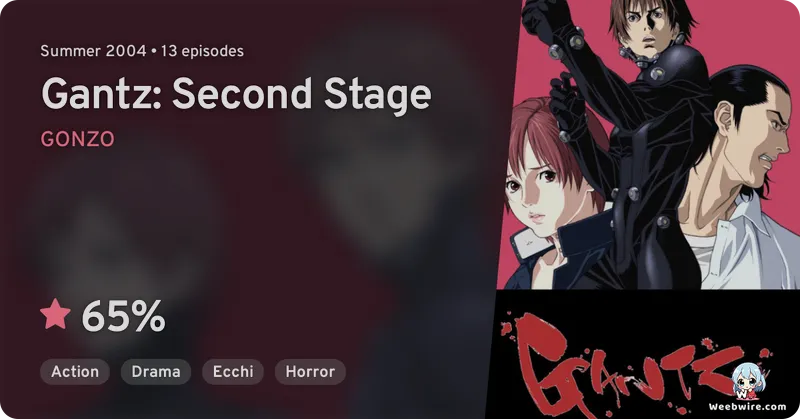Unveiling the Enduring Legacy of Gantz: Second Stage: Groundbreaking Animation Meets Divisive Narrative Conclusion

Premiering in 2004, Gantz: Second Stage emerged as a visceral continuation of the psychologically intense Gantz series. It quickly cemented its reputation for unrelenting brutality, complex moral dilemmas, and pioneering animation techniques. This season plunged deeper into the enigmatic Gantz room, introducing more terrifying alien adversaries while maintaining its signature blend of explicit gore, psychological horror, and pervasive existential dread.
Pioneering Animation: A Visual Revolution
A defining characteristic of Gantz: Second Stage was Studio GONZO's revolutionary animation. In the early to mid-2000s, GONZO pioneered the integration of 3D CGI with traditional 2D animation, and this series served as a prime showcase. This bold fusion yielded a distinctive, hyper-realistic, and gritty aesthetic, enabling dynamic camera movements and meticulous rendering of Gantz equipment and alien anatomy. This groundbreaking visual approach marked a significant moment in anime production history, pushing boundaries for the genre.

The Controversial Anime-Original Ending
Gantz: Second Stage is perhaps most notably remembered for its controversial, entirely anime-original ending. Produced concurrently with Hiroya Oku's ongoing manga, GONZO opted to craft a unique storyline for the latter half of the season, providing a definitive, yet divergent, conclusion for protagonists Kei Kurono and Masaru Kato. This decision ignited considerable debate among fans. Some appreciated the anime's attempt at narrative closure, while others felt it significantly departed from the manga's evolving plot. This divergence remains a key piece of trivia and a prominent talking point among the fanbase.
Unflinching Portrayal of Violence and Adult Themes
The series' unflinching portrayal of extreme violence and adult themes further solidified its impact. Gantz: Second Stage never shied away from explicit gore, nudity, and the brutal realities of survival, with characters frequently facing grotesque ends. This level of graphic content, considered extreme for television anime, contributed to its cult status and broad appeal among mature audiences seeking an uncompromised narrative. The profound psychological toll on its characters was equally emphasized, showcasing the deep impact of their desperate circumstances.
The Enigmatic Gantz Ball
Adding to its mystique, the enigmatic Gantz ball's true purpose and origin remained largely unexplained throughout Second Stage. This amplified the series' pervasive sense of mystery and dread. Its arbitrary rules, points system, and constant threat of death kept both characters and viewers perpetually on edge, forcing a confrontation with the terrifying unknown that defined their existence.
A Lasting Legacy
Ultimately, Gantz: Second Stage stands as a powerful testament to GONZO's audacious artistic choices and a pivotal moment in the history of adult-oriented anime. Its original ending, groundbreaking CGI, and uncompromising depiction of violence set it apart, ensuring its place as a memorable, albeit polarizing, entry in the sci-fi horror genre that continues to captivate and challenge viewers to this day.
Credits
Gantz: Second Stage
Author
Hiroya Oku
Cover Art
Hiroya Oku
Studio
GONZO
Publisher
Shueisha
Producers





